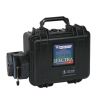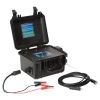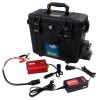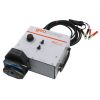Solinst Model 410 Peristaltic Pump
Features
- 5/8" OD medical-grade silicon tubing attaches easily to 1/2" OD down-hole tubing
- 5/8" tubing delivers from 120 ml/min to almost 3.5 L/min sampling rate
- 12 ft. power cord uses alligator clips for easy connection to nearly any 12VDC power source
- Free ground shipping
- Expedited repair and warranty service
- Lifetime technical support
- More
Overview
The Solinst Model 410 is designed for field use. The reversible flow Solinst Model 410 Peristaltic Pump is ideal for vapor sampling or water sampling from shallow wells and surface water. It can be used for vacuum pumping and pressure delivery of liquids or gases. The mechanical peristaltic operation uses rotating rollers to depress the silicon tubing, creating a vacuum, which displaces any fluid or gas in the chosen direction. It is effective to depths up to the suction lift limit, which varies with elevation, and can be as much as 33 ft or 10 m at sea level.
Compact and Lightweight
The Solinst Model 410 Peristaltic Pump has no vents, grates or openings. This makes it water-resistant, easy to use in the field and easy to maintain and repair. The metal case is extremely robust and water-resistant. A handle and easy-access control on the top of the pump makes it perfect for fieldwork. The Solinst Model 410 pump measures 13 x 5 x 6-1/2 (33 cm x 13 cm x 17 cm) and weighs only 8 lbs (3.6 Kg).
Easily Connect
A 12 ft. (4 m) power cord uses alligator clips to allow easy connection to almost any 12 volt DC power source that can supply at least 3-5 amps at maximum draw (such as auto, marine or small gel cell battery). The pump may be connected directly to the vehicle battery. The variable speed motor is reversible, has an easily replaced fuse, and has reverse polarity protection to prevent damage to the pump.
- (1) Model 410 peristaltic pump
- (1) 12 ft. power cord with alligator clips
- (2) 5/8" OD tubing clamps
- (1) 3 ft. length of 5/8" OD Silicon tubing
In The News
Three Decades of Research at Acton Lake
A multi-disciplinary team at Miami University, Ohio, has been studying the environmental change at Acton Lake for over three decades. Using three different NexSens buoys over this time, the team has an incredible archive of data that is helping build a picture of Acton’s past, present, and future. Until recently, a NexSens CB-50 buoy was used alongside other environmental monitoring at Acton Lake. In May 2025, the Miami team deployed a new XB-200 buoy , future-proofing their ongoing monitoring using real-time buoy systems. Acton Lake, a small hypereutrophic reservoir in southwest Ohio, covers 2.4km² and has a maximum depth of about 8m. The dam was built in 1956, and the lake has a large agricultural watershed.
Read MoreSource Water Monitoring in Albany, New York: Tracing Water Quality throughout Tributaries
Thousands of US cities pull their drinking water from natural source waters like reservoirs, rivers, and streams, making overall watershed health a key consideration for water providers. In Albany, New York, the Albany Department of Water and Water Supply delivers drinking water to over 100,000 residents as well as monitors and manages the larger drinking water supply watershed. Hannah Doherty, Environmental Specialist at the Albany Department of Water and Water Supply , spends her days working with a small team to monitor the drinking supply and the connected water bodies. Doherty explains, “We’re the first to encounter the water that ends up being the drinking water.
Read MoreWildfire Prevention in the Sierra Nevada Region with the Yuba Watershed Institute
Though recent wildfires have sparked new conversations about wildfire management and response, groups like the Yuba Watershed Institute have been monitoring the forests and water resources of the Sierra Nevada region for decades, managing approximately 5,000 acres of land with the Bureau of Land Management (BLM) and about 7,000 acres in private land partnerships. The goal of the Institute is to work with local communities and land agencies to improve watershed and forestry management through informed practices and public outreach. The goals of the Yuba Watershed Institute are three-fold: Improve the ability of fire suppression agencies like the California Department of Forestry and Fire Protection ( CAL FIRE ) and the US Forest Service.
Read More























